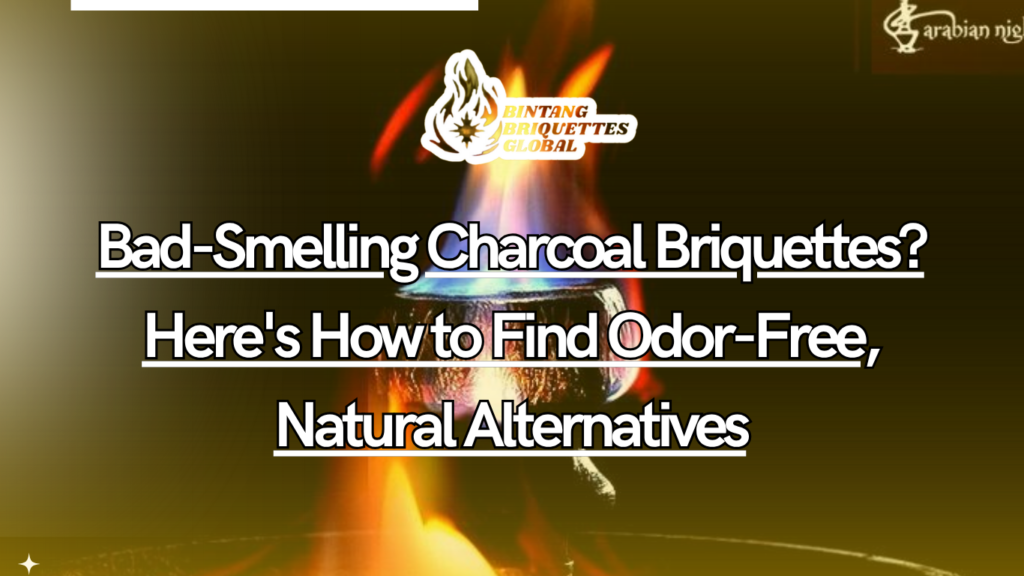1. Introduction Bad-Smelling Charcoal Briquettes
bintangbriquettes.com – Bad-smelling charcoal briquettes are more than just a nuisance—they can ruin your shisha session and even pose serious health risks. Whether you’re a casual hookah smoker or a BBQ enthusiast, choosing the right charcoal is crucial. In this guide, we’ll uncover why some charcoal smells bad, what ingredients are responsible, and how to choose clean, odor-free alternatives like natural coconut shell charcoal.
2. Why Charcoal Smells Bad: Understanding the Problem
Most cheap charcoal briquettes emit a sharp chemical smell when ignited. This often comes from binders, fillers, and synthetic additives used during production. These substances don’t fully burn and release volatile organic compounds (VOCs), which can alter taste and affect health.
3. Types of Charcoal Briquettes and Their Ingredients
There are several types of briquettes:
- Traditional Wood Briquettes: Often made from sawdust with additives.
- Lump Charcoal: Pure carbonized wood; burns cleaner but inconsistently.
- Coconut Shell Charcoal Briquettes: Eco-friendly, consistent, and clean-burning.
Cheaper options use industrial waste, starches, or even coal dust.
4. Common Additives That Cause Odor
Here are additives you should avoid:
- Sodium nitrate
- Borax
- Limestone
- Anthracite coal
- Mineral carbon
- Accelerants like paraffin
These are used to reduce cost and improve ignition but result in unpleasant odors.
5. Health Risks from Toxic Fumes in Low-Quality Charcoal
Low-quality briquettes can release:
- Carbon monoxide (CO)
- Benzene
- Toluene
- Sulfur compounds
These fumes can cause headaches, dizziness, and long-term respiratory issues, especially in enclosed environments like indoor shisha lounges.
6. Impact on Shisha Flavor and Smoking Experience
Cheap charcoal affects your session:
- Harsh smoke
- Bitter taste
- Fast-burning heat with uneven temperature
- Ash residue in your bowl
Using high-quality charcoal enhances the flavor of the molasses and maintains a smooth draw.
7. How to Test Charcoal for Purity and Odor
Try this at home:
- Visual check: Natural charcoal is black and solid; avoid grayish tones with visible residues.
- Smell before ignition: Should be neutral.
- Burn test: Place on burner—odor-free charcoal won’t emit strong smells or spark excessively.
8. What Makes Charcoal Odor-Free and Natural
Qualities of good charcoal:
- 100% organic raw material (like coconut shells)
- No fillers or accelerants
- Carbonized at high temperatures
- Low moisture content (≤ 6%)
- Hard, dense structure
9. Coconut Shell Charcoal: A Clean, Sustainable Choice
Coconut shell charcoal briquettes are known for:
- Neutral smell
- Long burning time (90+ minutes)
- Low ash residue
- Stable temperature
- Sustainability (recycled from agricultural waste)
They’re the top choice for premium hookah lounges worldwide.
10. The Manufacturing Process Matters
High-quality charcoal undergoes:
- Shell selection
- Clean carbonization
- Fine grinding
- Compression (using natural binders like tapioca)
- Drying at controlled heat
Each step influences odor, burn time, and performance.
11. Certifications and Standards to Look For
When shopping, look for:
- ISO 9001 (quality)
- FDA approval (for food-safe products)
- REACH Compliance (EU safety regulation)
- Halal certification (for Muslim markets)
These ensure the product meets health and safety standards.
12. Trusted Brands and What Sets Them Apart
Brands like:
- Bintang Briquettes
- Cocobrico
- Tom Cococha
- Cocourth
Stand out due to transparent sourcing, lab-tested emissions, and consistency in quality.
13. How to Read Packaging and Product Descriptions
Check labels for:
- “100% coconut shell”
- “No chemical additives”
- Ash content <2.5%
- Burn time specifications
- Country of origin (Indonesia is a leading exporter)
14. Tips for Proper Charcoal Storage to Maintain Freshness
Keep charcoal in:
- Dry, cool areas
- Airtight containers
- Away from sunlight and moisture
Poor storage can cause odor development and reduce performance.
15. User Experiences: Stories from Real Shisha Enthusiasts
Many users reported:
- “Switching to coconut charcoal gave me a smoother experience.”
- “No more headaches or eye irritation.”
- “Longer sessions without relighting.”
Consistency and purity make a big difference.
16. Frequently Asked Questions
Q: Why does my charcoal smell like chemicals?
A: Likely due to accelerants or fillers in low-quality briquettes.
Q: Is coconut shell charcoal really odorless?
A: Yes—when made properly, it has no smell and clean combustion.
Q: Can I use BBQ charcoal for hookah?
A: No, BBQ charcoal often contains additives unsuitable for inhalation.
17. Conclusion: Make the Switch to Natural Charcoal
Bad-Smelling Charcoal Briquettes The next time you light up your shisha, think beyond the flavor and consider what’s burning beneath it. Odor-free, natural coconut shell charcoal is the clear winner—not just for taste but for health, sustainability, and peace of mind. Don’t let bad charcoal ruin your session—or your lungs.

